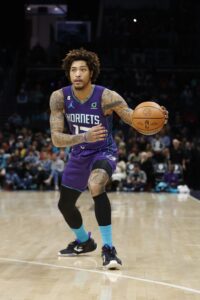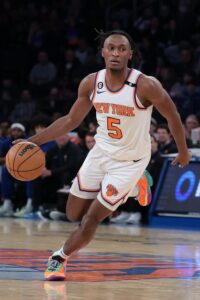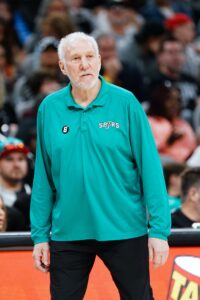The race for 2023 World Cup gold is down to just four teams, and they’ll all be in action in Friday’s semifinals, battling for the right to play in the championship game.
With less than 24 hours to go until the first of those semifinals tips off, let’s take a closer look at the matchups…
Canada vs. Serbia
Canada has had no shortage of NBA talent over the last two decades, but has finally put it all together in a World Cup, reaching its first ever semifinal. Shai Gilgeous-Alexander has been the main reason for the club’s success, leading the Canadians in categories across the board, including points (25.0), rebounds (7.2), assists (5.0), and steals (1.7) per game.
It hasn’t just been the SGA Show though. RJ Barrett (14.7 PPG) and Nickeil Alexander-Walker (10.0 PPG) been reliable secondary scoring options, Dillon Brooks and Luguentz Dort have played stifling defense, and Kelly Olynyk and Dwight Powell have allowed the Canadians to match up with bigger teams. Even without players like Jamal Murray, Andrew Wiggins, Trey Lyles, Shaedon Sharpe, and Cory Joseph, this is a very talented roster.
Serbia, meanwhile, is missing star center Nikola Jokic and point guard Vasilije Micic. In their absence though, Bogdan Bogdanovic has emerged as an effective leading man, averaging 18.8 points, 4.8 assists, 3.2 rebounds, and 2.2 steals per night.
Big man Nikola Milutinov, whose NBA draft rights are held by Brooklyn, has provided the Serbians with a consistent presence up front, averaging 13.2 PPG and 8.8 RPG. Current NBA players like Nikola Jovic (10.7 PPG) and Filip Petrusev (9.8 PPG) have chipped in too, as has former NBAer Marko Guduric (8.3 PPG, 3.8 APG).
Canada has more high-level NBA talent than Serbia and is currently listed as a 5.5-point favorite, per BetOnline.ag. But the Serbians have more experience playing together in international events, so this one could go either way.
United States vs. Germany
Even without its A Team, the United States is the heavy frontrunner to win the World Cup as the only squad in Manila made up entirely of NBA players. Team USA’s roster is deeper than any others at the World Cup, so head coach Steve Kerr has plenty of options if certain players are struggling.
Anthony Edwards (17.3 PPG) has been USA’s go-to scorer so far, but he had just three of the team’s 100 points in a blowout quarterfinal win over Italy, with Mikal Bridges, Tyrese Haliburton, Austin Reaves, Jalen Brunson, Brandon Ingram, and Paolo Banchero providing the necessary offense. While a total of nine Team USA players have averaged at least 16 minutes per night so far, none have played more than 23 MPG, as Kerr has taken advantage of the depth available to him.
Still, the U.S. isn’t unbeatable. The club lost to Lithuania in the second round of the World Cup and only narrowly defeated Germany in an exhibition game prior to the tournament.
The Germans are the only undefeated squad left at the World Cup, having been led by NBA players Dennis Schröder (18.0 PPG, 6.3 APG), Moritz Wagner (12.8 PPG, 5.7 RPG), and Daniel Theis (10.7 PPG, 5.3 RPG). Franz Wagner also made his return from an ankle injury in Wednesday’s quarterfinal and will be a key factor in Friday’s semifinal.
Like the U.S., Germany showed on Wednesday that it can win even when its top scorer has an off night. Schröder was just 4-of-26 from the field, but the Germans pulled out a two-point victory over a tough Latvian team.
 The 15th pick of the 2015 draft, Oubre has earned at least $12MM in each of the past four seasons. He averaged a career-high 20.3 points in 48 appearances with the Hornets last season while snatching 5.2 rebounds and 1.4 steals per game.
The 15th pick of the 2015 draft, Oubre has earned at least $12MM in each of the past four seasons. He averaged a career-high 20.3 points in 48 appearances with the Hornets last season while snatching 5.2 rebounds and 1.4 steals per game. Let’s use Knicks guard
Let’s use Knicks guard 